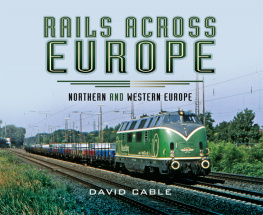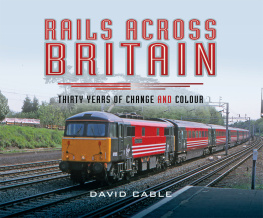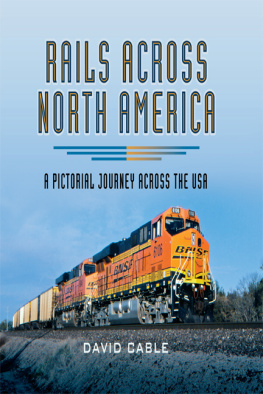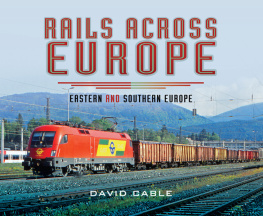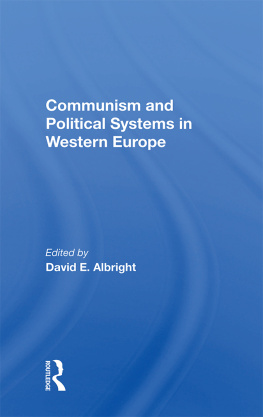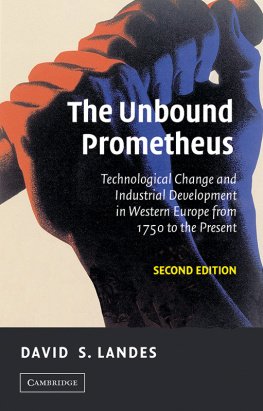Cable David - Rails Across Europe Northern and Western Europe
Here you can read online Cable David - Rails Across Europe Northern and Western Europe full text of the book (entire story) in english for free. Download pdf and epub, get meaning, cover and reviews about this ebook. year: 2016, publisher: Pen & Sword Books, genre: Home and family. Description of the work, (preface) as well as reviews are available. Best literature library LitArk.com created for fans of good reading and offers a wide selection of genres:
Romance novel
Science fiction
Adventure
Detective
Science
History
Home and family
Prose
Art
Politics
Computer
Non-fiction
Religion
Business
Children
Humor
Choose a favorite category and find really read worthwhile books. Enjoy immersion in the world of imagination, feel the emotions of the characters or learn something new for yourself, make an fascinating discovery.
- Book:Rails Across Europe Northern and Western Europe
- Author:
- Publisher:Pen & Sword Books
- Genre:
- Year:2016
- Rating:5 / 5
- Favourites:Add to favourites
- Your mark:
- 100
- 1
- 2
- 3
- 4
- 5
Rails Across Europe Northern and Western Europe: summary, description and annotation
We offer to read an annotation, description, summary or preface (depends on what the author of the book "Rails Across Europe Northern and Western Europe" wrote himself). If you haven't found the necessary information about the book — write in the comments, we will try to find it.
Rails Across Europe Northern and Western Europe — read online for free the complete book (whole text) full work
Below is the text of the book, divided by pages. System saving the place of the last page read, allows you to conveniently read the book "Rails Across Europe Northern and Western Europe" online for free, without having to search again every time where you left off. Put a bookmark, and you can go to the page where you finished reading at any time.
Font size:
Interval:
Bookmark:
First published in Great Britain in 2016 by
Pen & Sword Transport
An imprint of Pen & Sword Books Ltd
47 Church Street
Barnsley
South Yorkshire
S70 2AS
Copyright David Cable 2016
ISBN: 978 1 47384 428 5
PDF ISBN: 978 1 47384 431 5
EPUB ISBN: 978 1 47384 429 2
PRC ISBN: 978 1 47384 430 8
The right of David Cable to be identified as the author of this work has been asserted by him in accordance with the Copyright, Designs and Patents Act 1988. All rights reserved. No part of this publication may be reproduced or transmitted in any form or by any means, electronic or mechanical, including photocopy, recording or any information storage and retrieval system, without the prior written permission of the publisher. nor by way of trade or otherwise shall it be lent, re-sold, hired out or otherwise circulated without the publishers prior consent in any form of binding or cover other than that in which it is published and without a similar condition including this condition being imposed on the subsequent purchaser. David Cable 2016
Printed and bound in India by Replika Press Pvt. Ltd.
Pen & Sword Books Ltd incorporates the imprints of Pen & Sword Archaeology, Atlas, Aviation, Battleground, Discovery, Family History, History, Maritime, Military, Naval, Politics, Railways, Select, Social History Transport, True Crime, and Claymore Press, Frontline Books, Leo Cooper, Praetorian Press, Remember When, Seaforth Publishing and Wharncliffe.
For a complete list of Pen & Sword titles please contact
Pen & Sword Books Limited
47 Church Street, Barnsley, South Yorkshire, S70 2AS, England
E-mail:
Website: www.pen-and-sword.co.uk
DAVID CABLE OTHER PUBLICATIONS
Railfreight in Colour (for the modeller and historian)
BR Passenger Sectors in Colour (for the modeller and historian)
Lost Liveries of Privatisation in Colour (for the modeller and historian)
Hydraulics in the West
The Blue Diesel Era
Rails Across North America A Pictorial Journey Across the USA
Rails Across Canada A Pictorial Journey Across Canada
Rails Across Europe Eastern and Southern
Contents
Introduction

From the early days of proper railways being developed in England, Railway Mania spread a spiders web of lines throughout Europe, partly financed by speculative business entrepreneurs and partly by communities and states. In many cases, lines were built to keep other companies lines out of an area, the result of which being that many were unremunerative and have subsequently been closed. By the end of the nineteenth century, the network of railways was virtually complete, and it was not until the 1970s that any major new construction took place with the development of High Speed lines in France and Germany, followed by the Channel Tunnel in the 1990s, the connection between the Channel Tunnel and London being opened in the 21st century, and now developments in Poland, Belgium and the Netherlands.
Except for Norway and parts of Scotland and Wales, North and West Europe is generally fairly flat, so that locomotives of moderate power were manufactured of a size able to cope with ever increasing loads, relying on banking engines where sharp gradients necessitated. Apart from the Romanov Empire and Ireland, the standard gauge used in Great Britain, 4 8/ (1435mm), was adopted, albeit with a larger loading gauge than in the British Isles, which has restricted the use of wagons of the Continental mainlands being able to work on British tracks. Rolling stock moving to and from Russia, the Baltic states and Finland, where the track gauge is 5 0 (1520mm), have to change bogies, now a fairly quick procedure, whilst the railways in Ireland, which use a 5 3 (1600mm) gauge, are quite divorced from the rest of Europe.There are, in addition, a number of lines of narrower gauges which serve specific areas, and had the advantage of being cheaper to build.These are seen more in the east than the west of this area of Europe.
Around the end of the nineteenth century, progress was being made in electrifying railways, and this has become widespread on main lines throughout this part of Europe. In the main, overhead wiring systems are used, the exceptions being in the south of England, and most city Metro lines, where 3rd rail pick up is used. OHE voltages vary from 1.5/3 kV DC in Belgium, Netherlands and parts of France, 15kV AC in Germany, Austria and Switzerland), and 25kV elsewhere.With more international through working of trains, locomotives are being increasingly fitted for multi-voltage electrics. Unfortunately, different safety systems in many countries still restrict total flexibility, but EU diktats are starting to resolve this problem.
Passenger services comprise High Speed trains formed of Electric Multiple Unit sets, main line expresses mainly hauled by locomotives, local services also using EMUs, and city Metro services. Main line services still provide food of some sort, but sleeping cars have largely disappeared since the speeds of trains now largely complete journeys in daylight hours. Freight services are all loco hauled, and these have developed widely into Trans European workings carrying bulk loads and containers, rather than individual wagon type services. As a result, most small local freight yards have been abandoned. Whereas in former times the railways in each country were either state controlled or were self-contained corporations, the last thirty years have seen a marked increase in companies using Open Access opportunities to gain business from the larger units, often taking some of the more profitable work.
Northern European electric locomotives are now predominantly built by five manufacturers,Alstom, Bombardier, PESA, Siemens and Vossloh with General Motors/EMD having major penetration with diesel locomotives and power units. Locos have increased in power over the years, and have become increasingly sophisticated with multi-voltage and safety equipment adding to costs, such that several rail companies, particularly the Open Access groups, prefer to lease locos rather than purchase them outright.The leasing companies have included Dispolok, MRCE, Railpool and ELL, whilst in Great Britain, all rolling stock is leased from the ROSCO rolling stock finance houses. Other rolling stock has tended to increase in size, particularly freight wagons, which are now almost all carried on bogies. Coaching stock is somewhat longer, with more facilities for disabled persons, but less room for passengers luggage, and often seats which do not line up with windows. Trains for local workings and suburban areas almost all now are fitted with sliding doors.
So in the twenty-first century, the situation in North and West Europe is that several countries still have state subsidised and controlled railways, whereas others have split their operations into business sectors under an overall umbrella, and some have privatised their systems into various profit making franchises.
The purpose of this book is to show a selection of classes, locations and colour schemes in the different countries that have been seen over the last thirty years.The pictures in this book are almost all of my own, taken during holidays and business trips over the last thirty years, supported by some photos taken by my friend, Murray Lewis, who has visited places to which I have not been, and for which I thank him. A few photos in my collection were taken by Steve Sachse (now deceased), who left no details of the subjects. Detective work by Brian Garvin and Keith Fender has filled in most gaps, for which I thank them as well. Some of my pictures from the 1970s were taken on film of dubious manufacture and quality. I apologise for these, but since they are of sufficient historic interest, I have done my best with Photoshop to make them worthy of inclusion.
Next pageFont size:
Interval:
Bookmark:
Similar books «Rails Across Europe Northern and Western Europe»
Look at similar books to Rails Across Europe Northern and Western Europe. We have selected literature similar in name and meaning in the hope of providing readers with more options to find new, interesting, not yet read works.
Discussion, reviews of the book Rails Across Europe Northern and Western Europe and just readers' own opinions. Leave your comments, write what you think about the work, its meaning or the main characters. Specify what exactly you liked and what you didn't like, and why you think so.

